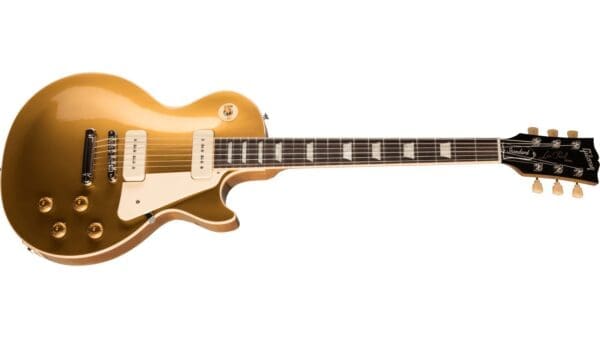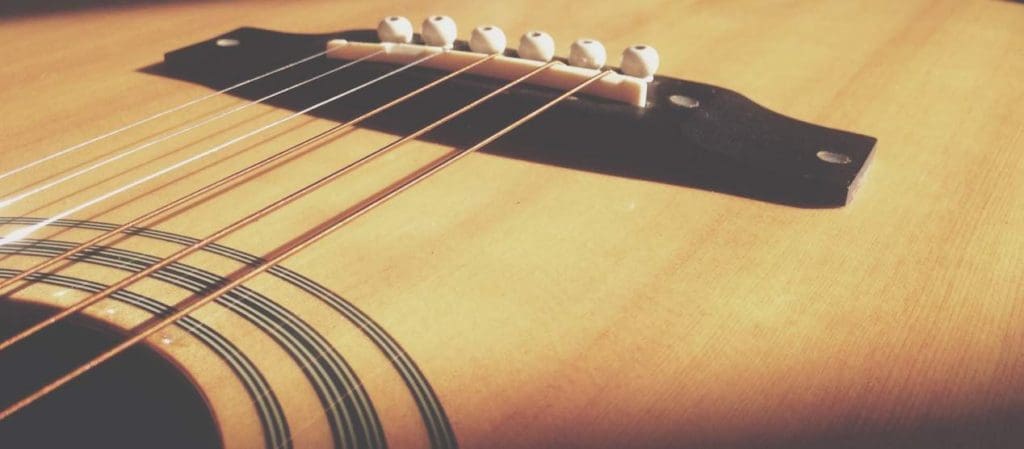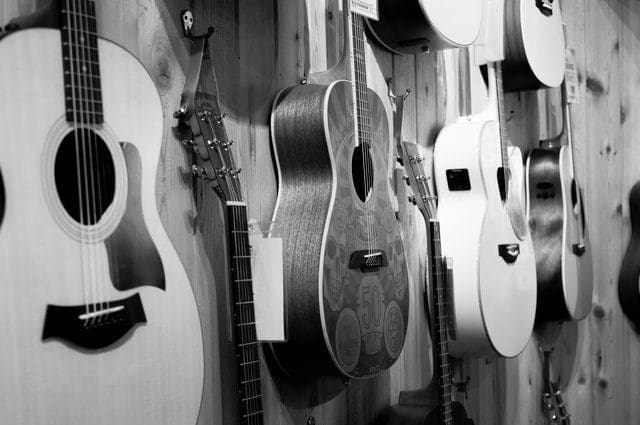
Last update 5/2/2024
Home of the glossaries of terms for the Gibson Les Paul electric guitar described here are also valid for many other electric guitars and acoustics. That is to say, many of these terms are worth remembering; alternatively, bookmark this page for future reference.
Table of contents
60’s neck
The flatter, thinner neck profile was adopted on Les Pauls and most SG Electric guitar models in the 1960s. Conversely, the slim-taper neck is another name for it.
Pickup 490R
A neck (or R for rhythm) pickup from Gibson’s Modern pickup range uses Alnico 2 magnets to deliver a conventional humbucker tone with boosted highs. In either case, they are usually used in conjunction with a 490T bridge pickup.
Pickup 490T
A bridge position (or T for treble) pickup from Gibson’s Modern electric guitar pickups family uses Alnico 2 magnets to deliver a classic humbucker tone with boosted highs. Nonetheless, they are usually used in conjunction with a 490R pickup.
Pickup 490R
The 496R is a ceramic magnet pickup from Gibson’s Modern pickup line that produces a hotter output, usually for the neck position. As a rule, the R stands for “Rhythm,” on the neck position on an LP’s pickup selector switch is generally called. Incidentally, for the bridge position, the 496R is usually paired with the 500T pickup (the “T” stands for “Treble” pickup switch setting).
Pickup 498T
Namely, a bridge position pickup from Gibson’s Modern line of pickups with ceramic ringed magnets for improved OutputOutput, mids, and highs (and less bottom than the alnico magnet BurstBucker).
Pickup 500T
Namely, Gibson’s Modern line bridge position pickup features ringed ceramic magnets for improved power, richer highs, and increased sustain and definition (and less bottom than the alnico magnet BurstBucker). So, they are usually used in conjunction with the 496R neck position pickup.
Pickup 57 Classic
In general, Gibson’s range of Historic Humbuckers includes the ’57 Classic. Alnico 2 magnet material and balanced coil windings produce vintage sounds with richer tones.
Pickup 57 Classic Plus
From Gibson’s Historic Humbucker line, the ’57 Classic Plus. For higher OutputOutput, Alnico 2 magnets and slightly overwound coils are used.
A grade maple
A maple rating indicates that the wood is completely clear, with no mineral streaks or other flaws. Consequently, there isn’t much figuring or “flame” in this one.
AA grade maple
Namely, mostly figured, or what some term “flamed” Maple, it has a lot of figuring (more than half).
AAA grade maple
Dramatically flamed or figured
AAAA grade
Namely, Maple exceptionally intensely figured or flared
ABR-1 bridge
For the most part, no different from the Tune-O-Matic bridge. Consequently, It is the part designation of Gibson’s first fully adjustable bridge. They are used in conjunction with a separate stop tailpiece as a final point. See Tune-O-Matic.
Abalone
A sea mollusk with an ear-shaped shell coated with mother-of-pearl is used for guitar inlays.
Alnico magnets
Namely, they are constructed of aluminum, nickel, and cobalt alloys, hence the name. Magnets in pickups are made of this material. Alnico 2 (also known as Alnico V) produces a sweet, conventional humbucker tone, while Alnico 5 (also known as Alnico V) is a little louder and more pro-sounding.
Appointments
In general, the cosmetic components of a guitar’s body, neck, and headstock that enhance the guitar’s beauty and value are known as appointments. Binding, inlays, and hardware are all included in the appointments list.
Auto trim tuner
Tuning machines with built-in cutters that trim excess string left hanging out of the tuning post are known as auto-trim tuners.
Beveled
In general, square edges on a guitar body, pickup, or other surfaces that have been reduced to sloping edges are referred to as beveled. Bevels make it easier for the guitar to rest on the guitarist’s rib cage.
Bigsby vibrato
A tailpiece with a bar that allows guitarists to adjust the strings’ tension and pitch. Usually known as a “tremolo bar” or a “whammy bar.”
Binding
In short, a decorative finish that covers the joint between the body and the top of the book or between the Fretboard and the neck—is also used to conceal the Fretboard’s connection to the neck. Also, the number of layers in binding is referred to as ply, for example, 3-ply or 7-ply.
Bolt-on neck
In general, a neck with three or four wood screws running through the back of the body and into the back of the neck is attached to a fitting slot in the body. In short, this method of attaching necks was crucial in creating the electric guitar since it cut manufacturing costs, making electric guitars more inexpensive. You can replace, alter, or repair a bolt-on neck.
Sunburst
Abbreviated as “burst.” See the Sunburst finish for more information.
BurstBucker
The brand name for Gibson’s Historic Humbucker Pickups.
BurstBucker
Type 1, Type 2, and Type 3 humbucker pickups are copies of “Patent Applied For” humbucker pickups seen on early Les Pauls and contain Alnico 2 magnets. The breezy tone is present in all three varieties. The Type 1 pickups have slightly underwound coils that are imbalanced. Type 2 coils are wound to exact specifications. Type 3 coils are somewhat overwound and imbalanced.
BurstBucker Pro
Pickups include Alnico 5 magnets and wax potting and have a greater bite and brightness “Patent Applied For” tone.
Carved maple top
A 3/8″ piece of Maple has been carved into a curved shape and laminated to the guitar body’s rear part (the back is usually made of mahogany).
Carved non-figured maple top
A maple top with no figuring or “flame” wood.
Ceramic magnet
To produce a “hotter” output, ceramic magnets are employed in pickups like Gibson’s 500T, Alnico magnet, and OutputOutput.
Chambered
A guitar body with precisely selected cavities or dynamic sound chambers routed into it is called “chambered.” Not to be confused with drilled “weight relief” holes. Les Paul models have this feature.
Double-cut
A guitar with two cutaways is known as a double-cut.
Double-potted
A pickup dipped twice in wax for a tighter seal prevents extraneous vibrations from causing microphonic feedback.
Ebony
In general, a rich, strong wood is utilized in the fretboards of higher-end Les Pauls. The Fretboard is the same as the fingerboard.
Finish
The guitar’s wood body, neck, and headstock are a protective and decorative finish.
Fretboard
The Fretboard, also known as a fingerboard, the Fretboard of Les Pauls, is composed of rosewood or ebony and is laminated on top of another piece of wood, usually mahogany. Metal frets are hammered into the Fretboard with care.
Fretboard Radius
Refers to the width of the curvature at the top of the Fretboard from edge to edge.
Fret size
The height and width of the fret wire determine the fret size. However, low frets are easy on the fingertips; they might make string bending difficult. The higher the frets, the higher the action. However, narrow frets wear down quickly, but larger frets last longer. Furthermore, tall and narrow frets are also very popular. (See Jumbo jets)
Gold hardware
Gold is highly decorative and is rust and corrosion-resistant. It is an appointment found chiefly on the hardware of higher-value Les Pauls.
Green tuning key
Sometimes known as “green vintage tuning keys,” these are tuning keys that have been given a patina to make them appear aged.
Grover tuners
Namely, a higher-quality tuner brand than the ones that often come with most guitars. They have enclosed, permanently oiled machine heads, allowing them to tune more smoothly and keep the strings in tune for extended periods. Grover has been producing machine heads for stringed instruments since the late 1800s.
Headstock
In general, the topmost section of a guitar neck, where the tuners are mounted, is the headstock.
Humbucker
Most LP guitars have a humbucker pickup. Two coiled coils are wired out of phase adjacent to each other in the humbucker pickup. Furthermore, most electrical hum caused by single-coil pickups is eliminated or reduced due to wiring the pickups in this fashion.
Intonation
Generally, it refers to a guitar’s capacity to remain in tune notes from fret to fret down the neck. In most cases, intonation can be changed if required.
Jumbo Frets
The breadth and height of the fret wire are referred to as jumbo frets, sometimes known as broad frets or super-size frets. Some lead guitarists who do a lot of string bending prefer this. Furthermore, higher fret wires allow the musician to bend the strings further. (See the fret size).
Inlays
Beautiful embellishments are usually made of mother-of-pearl, abalone, or acrylic material and are typically located in the fingerboard and headstock. However, Les Pauls most often uses block and trapezoid shapes in the Fretboard (fingerboard).
Kill switch
A switch that disables all pickups.
Kluson tuners
Namely, it is a higher-quality tuner brand than the ones that come with most guitars. They use improved materials and are of a high level of artistry. Also, it is for this reason they tend to tune more smoothly and retain the strings in tune for longer periods.
Lacquer
Also known as nitrocellulose, it is a clear or colorful coating sprayed in numerous layers onto the guitar body to provide a robust and durable surface. Many believe that nitro finishes allow the wood to breathe and offer more sustain and improved tone. (Actually, an ongoing debate ensues about (the truth of this)
Les Paul
He was a legendary guitarist and multitrack recording pioneer. He was one of the first solid-body electric guitar builders; also, and the Gibson Electric Guitar is named after him.
A limited-edition
In general, a guitar has a unique set of features and is produced in small quantities. Also, the serial number is frequently hand-stamped on the back of the neck to show the limited series that particular guitar was made. With this in mind, it is a detail that collectors seek to increase the instrument’s value.
Long-neck tenon
Namely, the neck section extending into the body for a more robust joint when the neck and body are cemented together is known as a long-neck or deep tenon.
Lyre Vibrola: a trapeze-style tremolo tailpiece that offers pitch-shifting effects by adjusting string tension. This form of string termination swings freely from the guitar’s tail, freeing the top of the string leverage.
Maple
Generally, a plank of solid, durable wood is usually utilized for the tops of Les Paul and SG models. The maple top is 3/8″ thick and bonded to the back (usually made of mahogany).
Mahogany
Namely, a solid, sturdy, but not overly hard hardwood is commonly chosen for LPs’ body and neck. Furthermore, midrange and bass tones are emphasized for a mellower or darker tone.
Midrange
The middle of the three tonal frequency ranges are low, medium, and high. The strength with which a guitar makes the sound in each of these three frequencies determines its overall musical character. A decent guitar should be able to create a blend of all three. For example, the precise mix—how much midrange vs. highs—is essentially a matter of personal taste.
Mini-humbuckers
In short, a smaller version of conventional humbuckers was initially included in the Les Paul Deluxe in 1968. As a result, the sound is described as sweeter and more “centered,” focusing on the midrange.
Neck-through or (Neck-thru)
A guitar is built around a single column of wood that expands from the tip of the headstock to the strap button at the tail. This column can either be a single piece or a few pieces glued (laminated) together side-by-side. The “wings” of the body wood are stuck onto the sides of this central column of wood. Also, neck-through guitars are more costly to make than bolt-on necks.
Nitrocellulose lacquer finish
A fast-drying synthetic finish popular in the 1950s and 1960s is now primarily utilized on reissue guitars from those eras. (see finish)
Nut
The nut determines the string spacing and height above the neck, where the headstock meets the neck. Bone, graphite, brass, nickel, Corian, or plastic can be used to make a string nut.
Nut width
The distance across the top of the Fretboard that affects the spacing between individual strings is known as the nut width. As a result, players with larger hands prefer wider fretboards.
Output
A guitar pickup’s output is the quantity of electrical signal it produces. Higher Output (or “gain”) implies the pickup can easily overdrive the amplifier. Consequently, it resulted in the hard-edged or distorted guitar tones that many rock musicians prefer. Also, the 500T in the Les Paul Classic is an example of a high-output pickup.
“Patent Applied For”
This legend was stamped on early adaptations of the Gibson humbucker. The sound of these pickups on the “Sunburst” Les Pauls from 1958 through 1960— mainly when played through a Marshall amp. Consequently, it created the rich, mellow, and warm distortion found on numerous rock classic blues recordings within the late ’60s and in its reissues of vintage guitars. Gibson endeavors to realize the vintage enhanced Patent Applied for tone in its BurstBucker Sort 1, 2, and 3 pickups.
Pickguard
They are made of plastic (celluloid, vinyl, PVC, acrylic) or covered with fabric. They can also be made of Plexiglas, glass, wood, textures, metals, or plywood. Pickguards may be made of a single layer (utilize) or numerous layers, for illustration, 3-ply or 5-ply. As a rule, pickguards are found underneath and around the strings to anticipate no harm caused by the guitarist’s strumming or picking.
Ply binding
Multiple-layer binding, such as 3-ply or 5-ply binding, is called ply binding. Multi-ply binding is more appealing than plain binding and can be found on more expensive guitars.
Potentiometer
In short, an electrical component (pot) with an adjustable knob or lever to control loudness and tone.
Quilt top
A maple top with a quilt-like pattern of figure or flame.
Rosewood
In short, a type of wood is utilized on some LP guitars’ fingerboards. Also, ebony fingerboards are typical on higher-priced versions.
Rounded neck
The neck profile on antique 1950s Gibson LPs is rounded instead of the narrower, flatter design on 1960s SGs.
Scale length
The measured distance between the nut and the saddle of the vibrating string. The SG’s 24-3/4″ scale length is shorter than the Fender Stratocaster (and Telecaster25-1/2″) scale length, derived from the conventional scale length for steel-string acoustic guitars. The SG’s (and Les Paul’s) lower scale length produces less tension, making it easier to play. Consequently, shorter Scale lengths are generally easier to play than Long scale length guitars because the shorter scale length has less String tension. Also, short-scale length has the benefit of playing string bends easier.
Seth Lover
In short, the designer created and patented the humbucker pickup, And so it was used initially on the Les Paul in 1957.
A set-in neck
It is cemented to the body rather than one that is bolted on. (also, see “through neck”).
Signature guitars
Gibson Custom Shop models are customized to employ the preferences of famous guitarists.
Single-coil Pickup
A guitar pickup with only one coil wrapped around a single magnet is called a single-coil pickup. Also, a single pickup’s tone is brighter than a humbucker’s, with less midrange and bottom, and is more prone to hum. The P-90 is a good example.
Slim ’60s neck
The rounded ’50s neck has a narrower, flatter taper or neck profile than the slim ’60s neck.
Slim-taper neck
Some players prefer a slim-taper neck to a rounder neck because it is flatter and thinner.
Stopbar tailpiece
A bridge/tailpiece combination replaced the trapeze tailpiece on Les Paul in 1954. It’s also found on a lot of SG models.
Strap Lock
It keeps the guitar strap from disconnecting from the guitar’s strap button.
Sunburst finish
A guitar finish in which the color is the lightest in the middle and gradually darkens as it fans towards the edge of the guitar body. So, the wood grain is often evident in the lighter sections of a sunburst guitar top.
Thin nitrocellulose lacquer finish
Nitro finishes are sometimes referred to as super-thin, super-light finishes that mimic the patina of aged vintage guitars. The procedure is costly since it takes weeks to complete. The wood breathes better with a thin nitrocellulose finish that thins out with time. Therefore, many believe the best tone finish is a satin finish.
Three-way switch: found on most guitars with two pickups, it regulates which pickups are active—typical switching positions are 1) bridge pickup, 2) bridge and neck pickups, 3) neck pickup.
Top hat knobs
Volume and tone knobs that are designed to look like a top hat. Vintage LPs and their copies contain this feature. They are available in two colors: black and gold. The amber tint of vintage top hat knobs develops with time.
Transparent colors: a thin lacquer finish that allows the guitar’s natural wood grain to show through.
Tune-O-Matic
Gibson’s adjustable bridge, introduced with the 1954 Les Paul Custom, is known as Tune-O-Matic (often abbreviated TOM). Adjusting their length and height can alter individual strings for better intonation. It’s found on a lot of Les Paul models.
Tuners
Tuning pegs (also called tuning keys or machine heads) are used to adjust the tension of individual guitar strings and, consequently, their pitch. For example, Grover and Kluson are two examples.
VOS = Vintage Original Spec
In short, a line of Gibson Custom Shop reissue guitars built to the exact specs of vintage guitars. Therefore, the guitar’s finish, hardware, and plastic parts may be aged as part of the VOS treatment.
Waxed pickups
A guitar pickup is dipped (or “potted”) in wax during manufacture to prevent microphonic feedback caused by undesired vibrations traveling from the guitar body to the pickup. So, except for BurstBucker Type 1 and Type 2, historically authentic copies of “Patent Applied For” pickups featured in early Les Paul and SG models used on all Gibson pickups. Pickup “Patent Applied For”
Wide frets
Most Gibson electric guitars had short, shallow frets until 1959. Some musicians like wide frets because they feel more at ease moving their fingers along the strings. However, some guitarists prefer short, wide frets because they find it easier to play the guitar.
Zebra pickups
The colors of the pickup bobbins are mismatched. Finally, the bobbins were first discovered in the late 1950s Sunburst Les Pauls when players reportedly removed pickup covers to improve the sound. Collectors respect zebra pickups because they signify a vintage guitar’s authenticity. They’re available on several new Gibson SG models.


